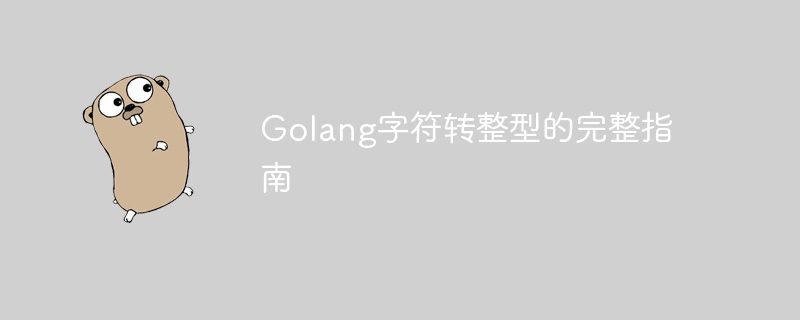Golang字元轉整型的完整指南
在 Go 語言中,字元轉整數的方法包括:使用 strconv.Atoi 函數將字串轉換為整數。使用 strconv.ParseInt 函數將字串轉換為指定基數的整數。使用 Unicode 字面值表示單一 Unicode 字符,並將其轉換為整數。

Go 語言字元轉整數型的完整指南
#在Go 語言中,字元型別(rune)可以表示Unicode 字符,而整數型別(int、int8 等)則表示數值。因此,在某些情況下,需要將字元轉換為整數。
字串轉整數
Atoi
#strconv.Atoi 函數將字串轉換為整數。
import (
"fmt"
"strconv"
)
func main() {
str := "1234"
n, err := strconv.Atoi(str)
if err != nil {
fmt.Println(err)
} else {
fmt.Println("Int:", n)
}
}輸出:
Int: 1234
ParseInt
#strconv.ParseInt 函數將字串轉換為指定基數的整數。
n, err := strconv.ParseInt(str, 10, 64) // 10 为十进制基数,64 为位数
單一字元轉整數
用 Unicode 字面值
Unicode 字面值可以表示單一 Unicode 字元。
r := '1' n := int(r - '0')
實戰案例
在處理使用者輸入或解析其他資料時,需要將字元轉換為整數的情況很常見。例如:
從命令列讀取整數
fmt.Println("请输入一个整数:")
var n int
fmt.Scan(&n) // 从 stdin 读入并解析为整数#處理JSON 資料
type Data struct {
Age int `json:"age"`
}
json.Unmarshal(data, &d) // JSON 数据反序列化为结构体解析檔路徑
path := "path/to/file.txt" size := path[len(path)-5:] // 获取文件大小部分 n, err := strconv.Atoi(size)
以上是Golang字元轉整型的完整指南的詳細內容。更多資訊請關注PHP中文網其他相關文章!

熱AI工具

Undresser.AI Undress
人工智慧驅動的應用程序,用於創建逼真的裸體照片

AI Clothes Remover
用於從照片中去除衣服的線上人工智慧工具。

Undress AI Tool
免費脫衣圖片

Clothoff.io
AI脫衣器

AI Hentai Generator
免費產生 AI 無盡。

熱門文章

熱工具

記事本++7.3.1
好用且免費的程式碼編輯器

SublimeText3漢化版
中文版,非常好用

禪工作室 13.0.1
強大的PHP整合開發環境

Dreamweaver CS6
視覺化網頁開發工具

SublimeText3 Mac版
神級程式碼編輯軟體(SublimeText3)

熱門話題
 Go的爬蟲Colly中Queue線程的問題是什麼?
Apr 02, 2025 pm 02:09 PM
Go的爬蟲Colly中Queue線程的問題是什麼?
Apr 02, 2025 pm 02:09 PM
Go爬蟲Colly中的Queue線程問題探討在使用Go語言的Colly爬蟲庫時,開發者常常會遇到關於線程和請求隊列的問題。 �...
 Go語言中用於浮點數運算的庫有哪些?
Apr 02, 2025 pm 02:06 PM
Go語言中用於浮點數運算的庫有哪些?
Apr 02, 2025 pm 02:06 PM
Go語言中用於浮點數運算的庫介紹在Go語言(也稱為Golang)中,進行浮點數的加減乘除運算時,如何確保精度是�...
 在 Go 語言中,為什麼使用 Println 和 string() 函數打印字符串會出現不同的效果?
Apr 02, 2025 pm 02:03 PM
在 Go 語言中,為什麼使用 Println 和 string() 函數打印字符串會出現不同的效果?
Apr 02, 2025 pm 02:03 PM
Go語言中字符串打印的區別:使用Println與string()函數的效果差異在Go...
 Go語言中`var`和`type`關鍵字定義結構體的區別是什麼?
Apr 02, 2025 pm 12:57 PM
Go語言中`var`和`type`關鍵字定義結構體的區別是什麼?
Apr 02, 2025 pm 12:57 PM
Go語言中結構體定義的兩種方式:var與type關鍵字的差異Go語言在定義結構體時,經常會看到兩種不同的寫法:一�...
 Go語言中哪些庫是由大公司開發或知名的開源項目提供的?
Apr 02, 2025 pm 04:12 PM
Go語言中哪些庫是由大公司開發或知名的開源項目提供的?
Apr 02, 2025 pm 04:12 PM
Go語言中哪些庫是大公司開發或知名開源項目?在使用Go語言進行編程時,開發者常常會遇到一些常見的需求,�...
 在Go語言中使用Redis Stream實現消息隊列時,如何解決user_id類型轉換問題?
Apr 02, 2025 pm 04:54 PM
在Go語言中使用Redis Stream實現消息隊列時,如何解決user_id類型轉換問題?
Apr 02, 2025 pm 04:54 PM
Go語言中使用RedisStream實現消息隊列時類型轉換問題在使用Go語言與Redis...
 GoLand中自定義結構體標籤不顯示怎麼辦?
Apr 02, 2025 pm 05:09 PM
GoLand中自定義結構體標籤不顯示怎麼辦?
Apr 02, 2025 pm 05:09 PM
GoLand中自定義結構體標籤不顯示怎麼辦?在使用GoLand進行Go語言開發時,很多開發者會遇到自定義結構體標籤在�...
 VSCode中如何解決Golang泛型函數類型約束被自動刪除的問題?
Apr 02, 2025 pm 02:15 PM
VSCode中如何解決Golang泛型函數類型約束被自動刪除的問題?
Apr 02, 2025 pm 02:15 PM
VSCode中Golang泛型函數類型約束的自動刪除問題在使用VSCode編寫Golang代碼時,用戶可能會遇到一個奇怪的問題。當...






